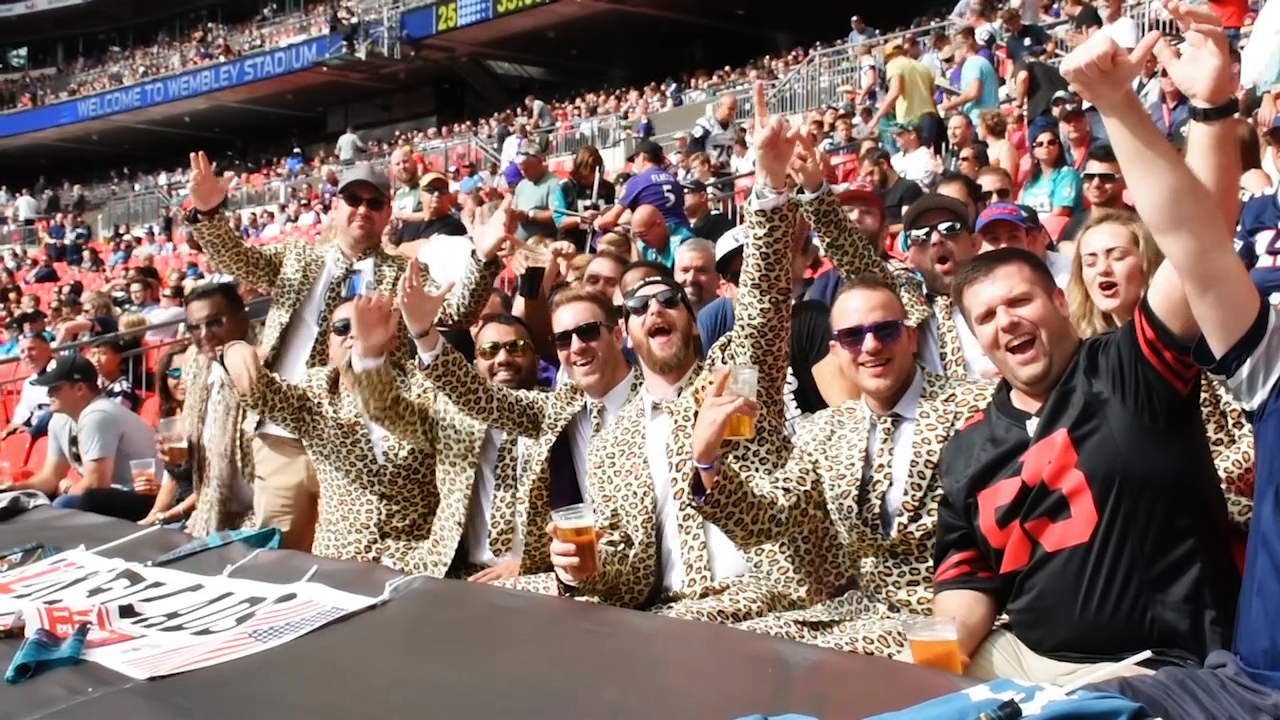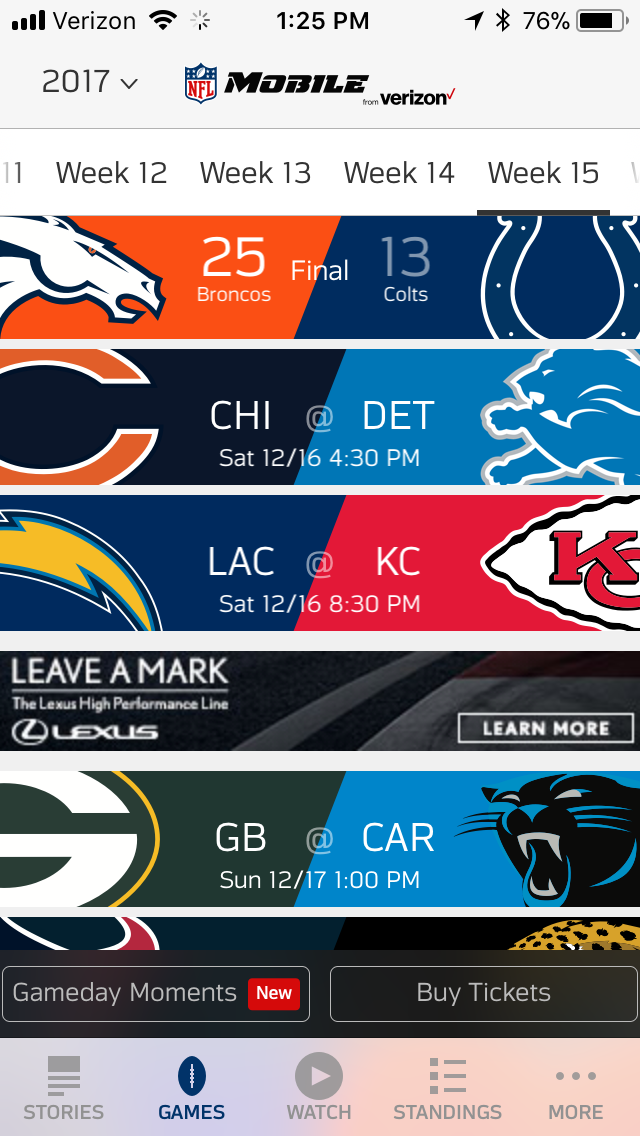Fresh Eyes: NFL aims to attract young British fans to the American game
LONDON – Ryan O’Donoghue and James Johnson are the only NFL fans among their friends at school, but when they arrived at Wembley Stadium for the Jaguars-Ravens game on Sept. 24, they were surrounded by thousands of people who share their passion for a foreign sport.
For the third consecutive year, the 17- and 18-year-old traveled two hours from their hometown in Northampton, England, to watch one of the NFL’s London games. The rest of the season, they get news and updates from the National Football League’s app and social media accounts.
Fans travel to the game wearing their team jersey of choice. ~ photo by Hannah Geller
In the eyes of the NFL, O’Donoghue and Johnson are part of a perfect scenario.
The league is targeting “young millennials” in the United Kingdom as its next big fan base, said Sarah Swanson, head of British marketing for the NFL. The league is aiming to reach ages 18 to 25 primarily, she said, because many people over that age have already decided whether they like American football.
The scene at the NFL’s games in London this fall suggested they are making progress. Hours before kickoff, the shopping-restaurant district outside Wembley Stadium became packed with thousands of fans, checking out a league-sponsored tailgate scene, watching highlight videos on a big screen and sipping a beer or two.
More fans, more Lads
There’s no real comparison to the nationwide love of soccer, what the English call football, and the next day it took some effort to find the score in a newspaper, but football American-style is more than a curiosity.
The Vikings’ 33-16 victory over the hapless Browns was the last game in London this season and the 21st overall — 18 played at Wembley and three at Twickenham.
This year, two games were held in each stadium for the first time. Jacksonville got things started with its 44-7 thumping of Baltimore. While the game wasn’t much on drama, the Jaguars’ win marked a new attendance-high for the NFL at Wembley, with 84,592. But not by much: Wembley averages 83,340 spectators for American football.
At the Jaguars-Ravens game, it looked as though every NFL jersey was represented among fans, who came not only from England but also continental Europe, in addition to some Americans traveling with their teams. Some English fans went all out, wearing purple wigs and tutus to support the Ravens.
A group that refers to itself as the NFL Lads came decked out in leopard-print tuxedos to represent Jacksonville. The men, who dressed as dolphins for Miami a week later, support the designated “home” team in London each week, despite the fact that guys within the group are personally partial to an array of NFL teams.

How the Lads got together says a little about English culture and modern technology.
They connected at NFL London games over the years because they all dressed in flashy outfits. Now, the group stays in touch through Whatsapp and social media accounts like Instagram. They even hand out business cards outside Wembley with the group’s social media usernames to gain more followers.
The NFL Lads, who are in their late 20s, estimate they take about 200 photos with fans over the course of a game day, from the pre-game tailgate until after the game, when they go to a bar in sight of the stadium.
Learning the Game
Inside Wembley, it was obvious that, while the NFL has developed a following, it is still educating newcomers to the game. Whenever there was a penalty or a play with a rules wrinkle, such as a fair catch, a definition of the ruling appeared on the stadium’s video screens.
It’s just one small example of how the NFL is using technology to reach fans, particularly younger ones.
The NFL is trying build a fanbase among the young, using social media, apps and other techniques to build awareness. ~ photo by Hannah Geller
“We often say we don’t compete against other sports for fans,” Swanson said. “What we compete against is people’s time. And when you’re younger, you kind of haven’t decided yet what all your passions are going to be.”
To appeal to British fans, the league has U.K.-specific handles for its social media accounts. On its Instagram page (@nfluk), which has about 65,100 followers and posts several times per day, fans can find scores, photos and clips of big plays.
Even though the NFL’s Facebook page is global, it also posts U.K.-specific content, such as news about ticket sales for the London games. The league also is launching a Facebook Live highlight show to gain more traffic.
One way the league has tried to reach fans is through a promotional video featuring the Philadelphia Eagles’ Jay Ajayi, a British-born player. In the video, Ajayi tours his hometown of London and attends an amateur American football practice.
“We’re trying to give people who may not know as much about the sport ways to get excited about it,” Swanson said.
When it comes to games like fantasy football and Madden NFL, Britain isn’t all that far behind the United States. This year, the NFL released a simplified version of fantasy football called the “NFL Challenge,” which requires fewer players and allows easier scoring.
Callum Sheppard, who attends Manchester Metropolitan University, became an NFL fan at age 12 after playing Madden NFL on Xbox. One of the first teams he played was the Patriots. Now, he roots for the team every season.
“I get quite a lot of stick because nobody really likes the Patriots that much, which is quite funny,” the 21-year-old student said.
At English universities and colleges, some people are trying out the game for real. American football is played at more than 90 schools, according to Swanson. To put the number in perspective, there are 130 schools in the United Kingdom, which also includes Wales, Scotland and Northern Ireland. However, the level of competition is not that high, and is similar to that of intramural sports in America.
Matt Sheppard, Callum’s older brother, plays flag football in Edinburgh, Scotland, as part of BAFA, the British American Football Association.
Flag football is seen everywhere as a less dangerous version of the full-contact game, though concerns about injuries, such as the long-term effects of concussions, have yet to become a major issue in Great Britain.
NFL controversies
“No matter what you do, it’s a contact sport, and it’s going to happen. It is what it is.” Ryan O'Donoghue
Still, hardcore NFL fans are aware of the safety worries when it comes to American football. Matt Sheppard, who seeks out NFL news, compared it to the dangers of rugby, a sport that has recently revised its contact rules.
O’Donoghue, who has suffered concussions from playing rugby, has seen news about CTE on the bottom of the television screen while watching Sky Sports, a network similar to ESPN. However, it wasn’t enough to make him want to learn more. In an interview, he didn’t even remember the acronym for the disease.
“No matter what you do, it’s a contact sport, and it’s going to happen,” O’Donoghue said. “Players know it now. They know there’s a risk … It is what it is.”
Another controversial topic was brought to light in London. Before kickoff at the Jaguars-Ravens game, a few players on both teams took a knee or linked arms to protest against disproportionate police violence against black Americans during the national anthem.
Some spectators in the stands, including Amir Shah of the NFL Lads, joined the players in protest, taking a knee himself.
“I don’t blame them,” Shah said. “They’re doing the right thing.”
NFL news via app
Thousands of NFL enthusiasts took to Regent Street on Sept. 30 for the NFL’s annual fan fest in London. On the street, which was blocked off to traffic, fans watched highlight videos on screens, kids threw footballs at targets to learn accuracy, and, despite the Dolphins-Saints game the following day, an array of teams were represented on fan jerseys.

Near one booth, three British fans gazed down the street in awe. Matthew Salisbury, 16, was accompanied by his brother Jack and friend AJ Mistry, both 19 years old. While they were being inundated with NFL news at the fanfest, the rest of the year, they have to find other ways to obtain that information.
For them, the most useful ways are through the NFL mobile app and NFL social media accounts. Mistry, a Cincinnati Bengals fan, took it to another level and turned on the app’s push notifications to receive news as soon as it breaks. The three fans joked about a friend who takes it a step further and searches for seemingly random NFL facts on Wikipedia.
Not universally loved
Average attendance at NFL games in London this season was better than all but the Dallas Cowboy's attendance average. ~ photo by Hannah Geller
It’s all enough to make the NFL sound wildly popular in Britain. But rewind to the Monday after the Jags beat the Ravens.
When Premier League fans watching Arsenal beat West Brom 2-0 in North London were asked whether they like the NFL, their responses were just about unanimous.
“No,” said 17- and 18-year-old boys, giving dirty looks at the mention of the idea.
“No,” said a group of Arsenal fans leaning against the floor-to-ceiling windows near the concession stands.
Some young men even cringed, calling American football “rubbish” and “weird.”
If they did want to watch, though, they could on BBC and Sky Sports, networks that televise the NFL. But Matt Sheppard, who’s been an NFL fan for 16 years, said the only times he’s seen coverage on BBC were highlight shows in the middle of the night.
Sky Sports airs more than 100 games per year. However, some fans complain the sports package is expensive, and without it, they say, NFL coverage is hard to find.
Johnson, who attended the Jags-Ravens game, pays £100 (about $135) per month for Sky Sports. Another group at the Jaguars-Ravens game said they split the cost of the package because it’s one of their only windows into the sport.
“Sky Sports dominates all sports in the United Kingdom, completely,” Johnson said. “If you don’t have Sky Sports, you absolutely have nothing whatsoever.”
But technology and social media are making American football more accessible than it’s ever been. According to Swanson, 24 million unique viewers from the United Kingdom saw some NFL content on television last year, a 50 percent increase from the previous year.
Matt Sheppard, 28, admits his two younger brothers are more avid social media users than he is, but he appreciates the NFL attempting to make the American game more visible for U.K. fans.
“It’s a lot easier than it was growing up trying to follow this sport,” Matt said.
And now he can’t get enough. The interest even has led to him watch college football on ESPN.
“Football is football,” Matt said. “I have no stake in other teams. Sometimes you just want to watch a game of football.”
~ 12.15.2017